Abstract
In Escherichia coli at least five enzyme activities required for the beta-oxidation of fatty acids are associated with a multienzyme complex composed of two subunits in alpha 2 beta 2 conformation (A. Pramanik et al., J. Bacteriol. 137:469-473, 1979). In the present work, the DNA sequence of the genes encoding these two subunits, fadB and fadA, has been determined. The direction of transcription was from fadB to fadA rather than from fadA to fadB, as suggested previously (S. K. Spratt et al., J. Bacteriol. 158:535-542, 1984). Only 10 nucleotides separated the coding sequences for the two peptides, confirming the suggestion that these genes form an operon. The peptides encoded by fadB and fadA were 729 amino acids and 387 amino acids, respectively, in length. The larger and smaller peptides had predicted molecular masses of 79,678 and 40,876 Da, respectively. Recently, the sequence of the fadA gene was published in a separate report (Yang et al., J. Biol. Chem. 265:10424-10429, 1990). In this work, most of the DNA sequence for fadA was confirmed, and 10 errors were corrected. Three of these nucleotide changes resulted in five amino acid residue changes predicted in the carboxy terminus of the fadA-encoded peptide. By comparison to other peptide sequences, the alpha subunit encoded within fadB had 31% perfect identity with the rat peroxisomal enoyl-coenzyme A:hydratase-3-hydroxyacyl-coenzyme A dehydrogenase trifunctional enzyme over the entire length of the two peptides. In agreement with the work of Yang et al., the beta subunit encoded within fadA had 35 to 45% perfect identity with five thiolase genes from different eucaryotic sources over the entire length of the peptide.
Full text
PDF
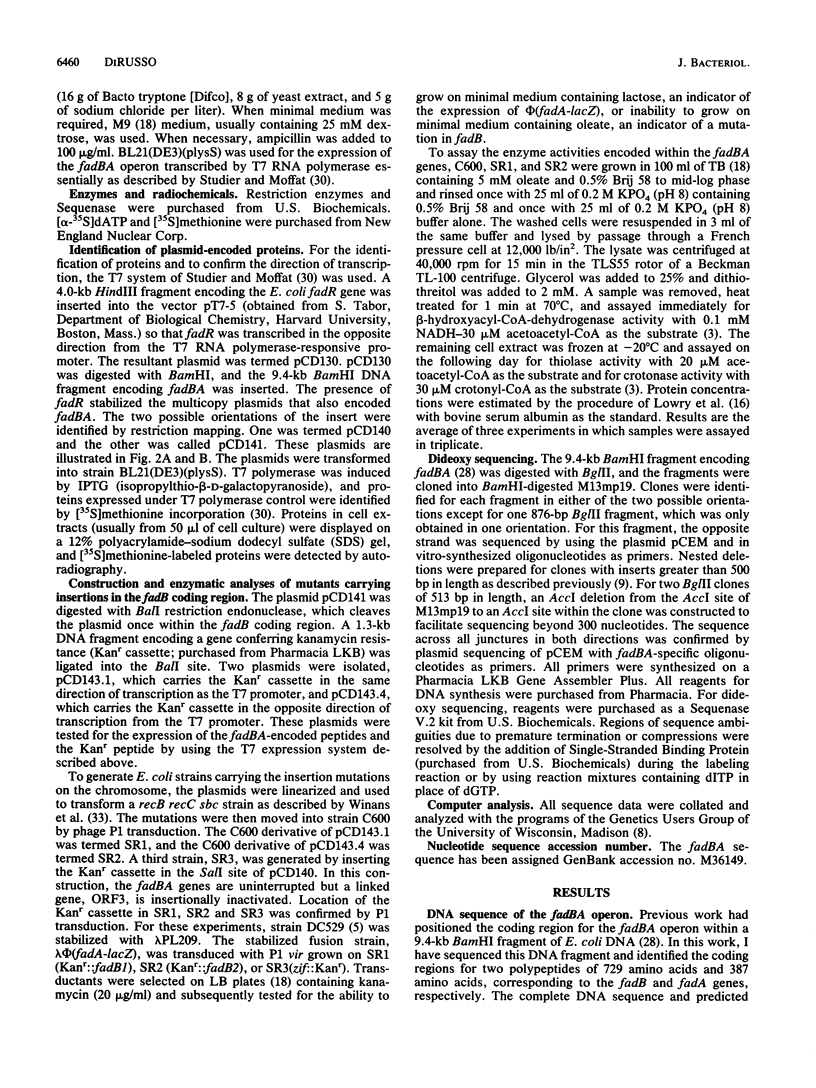
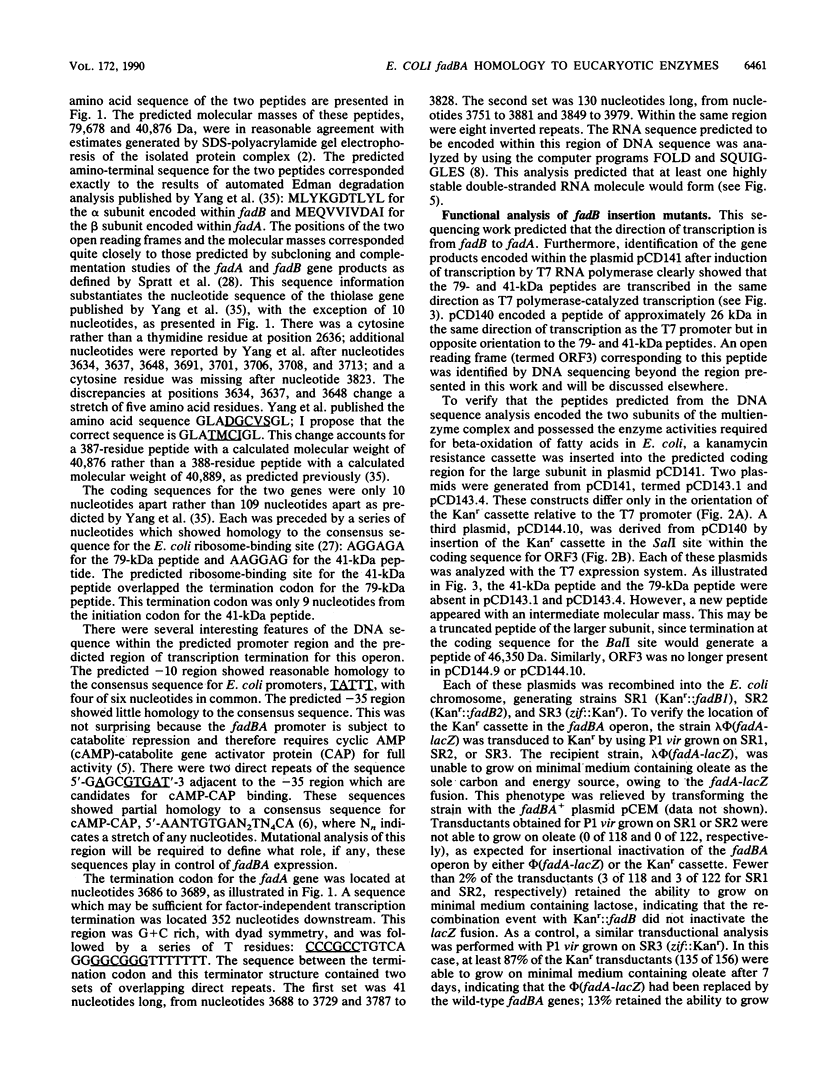
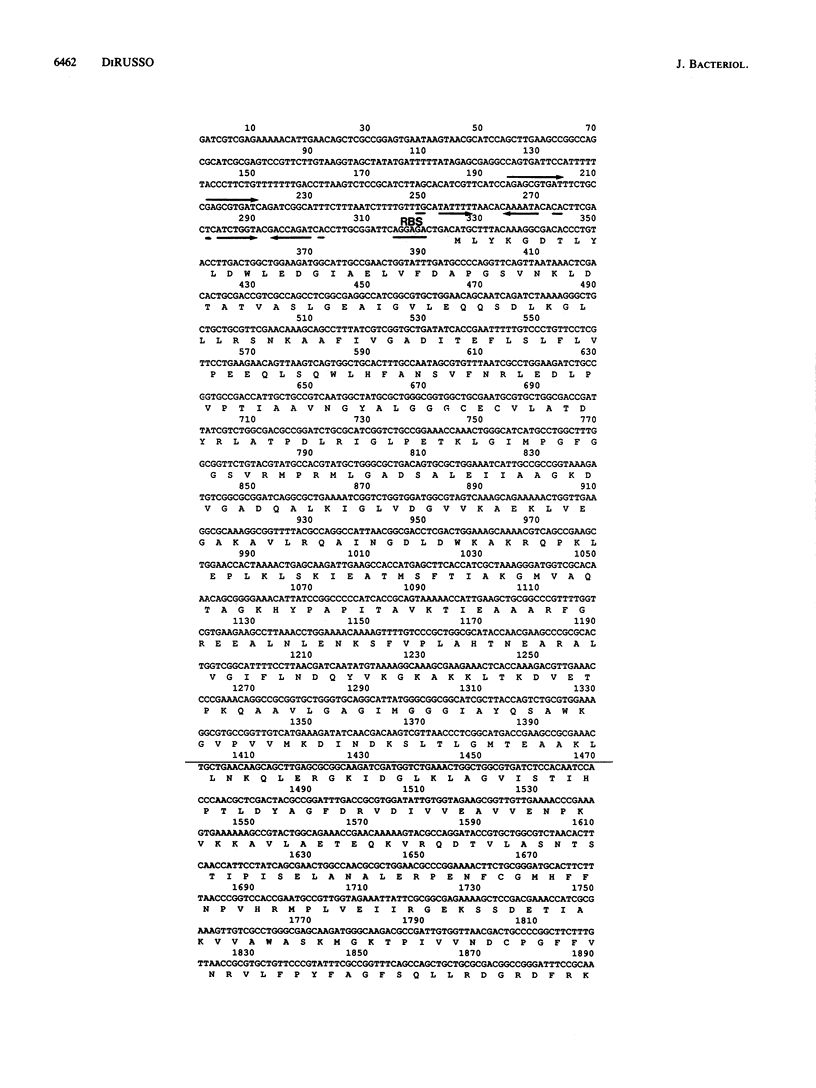
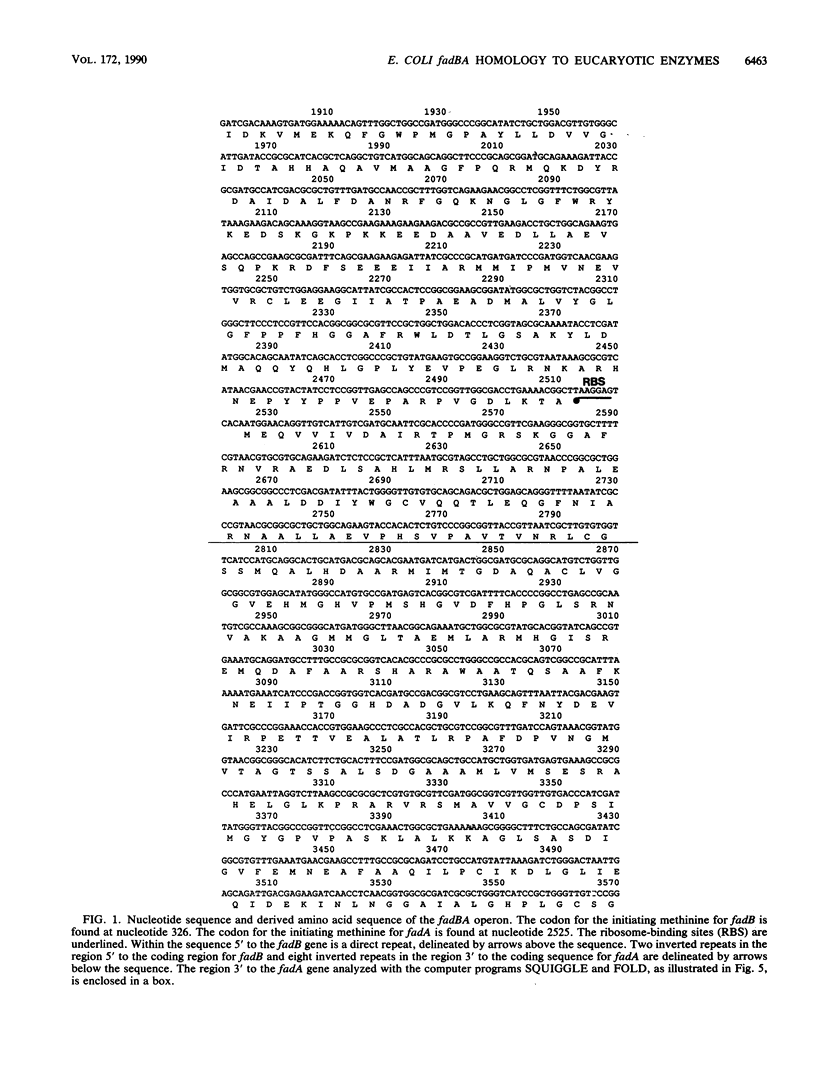
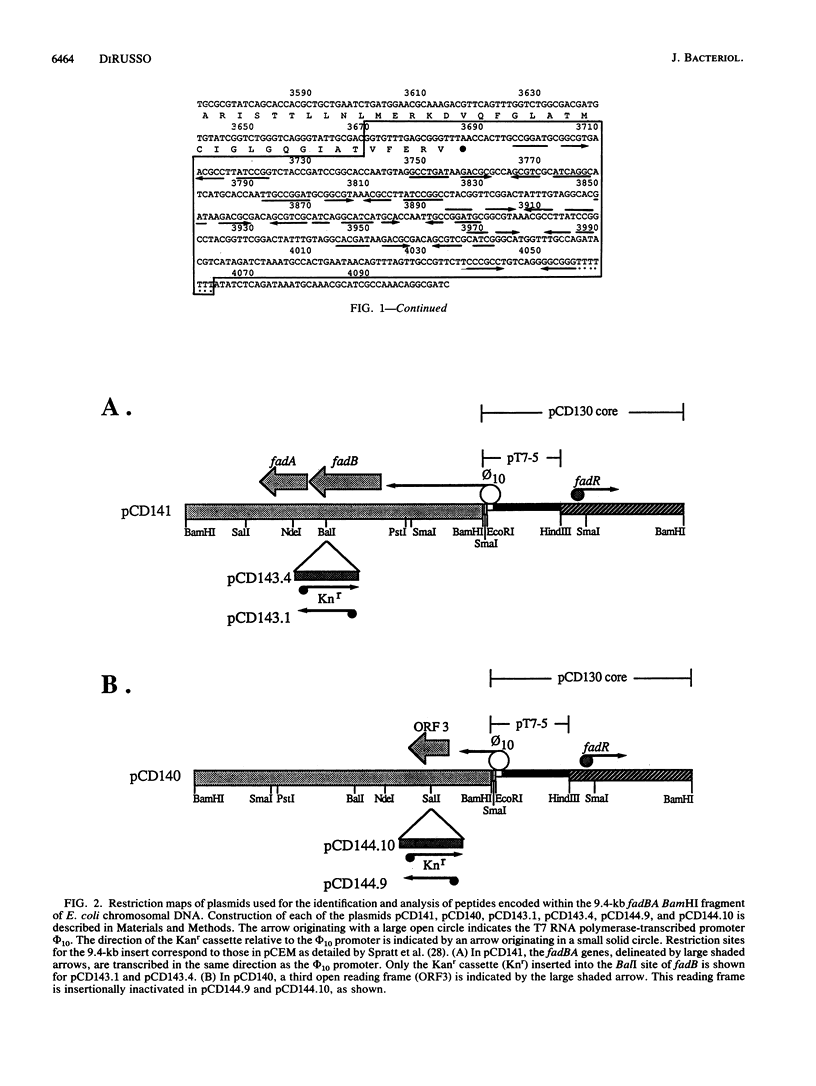
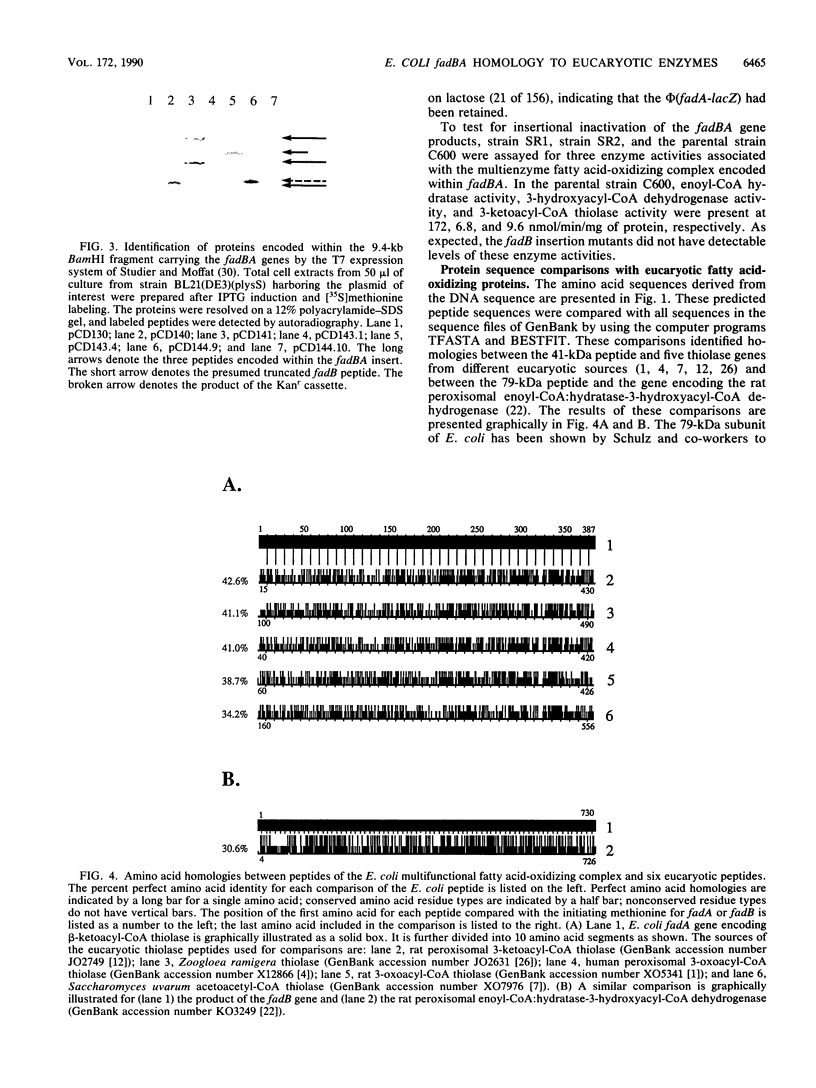
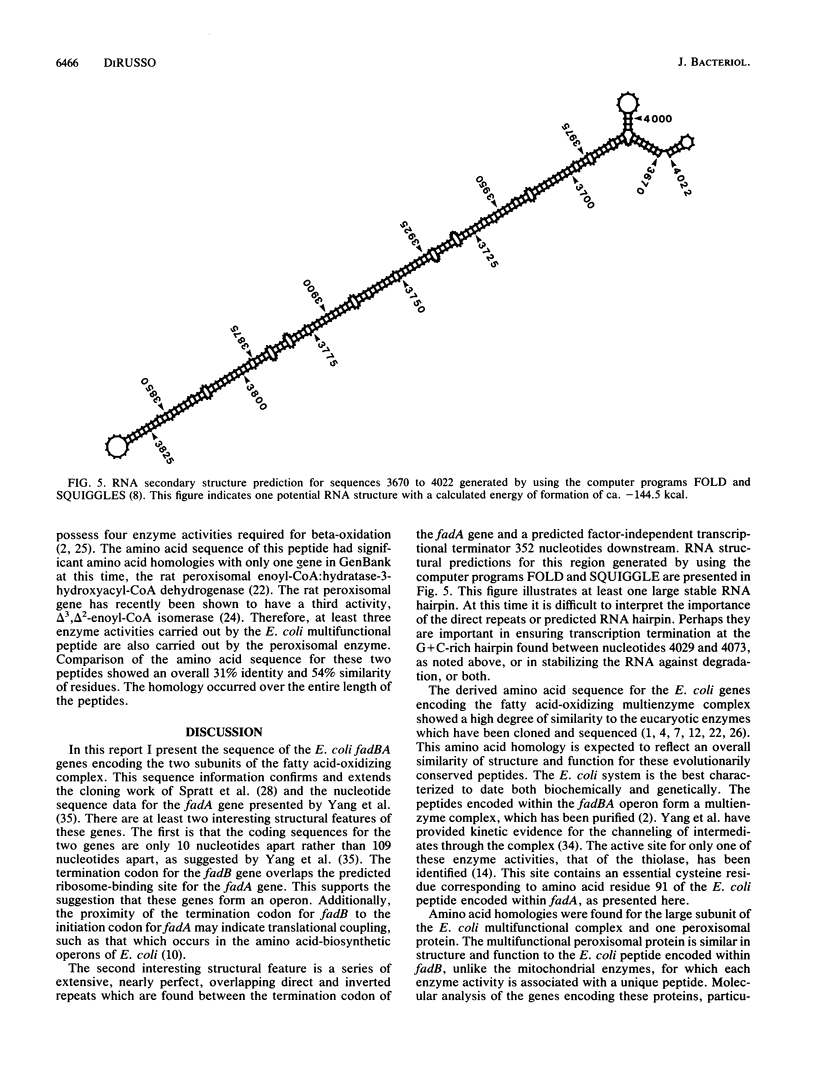
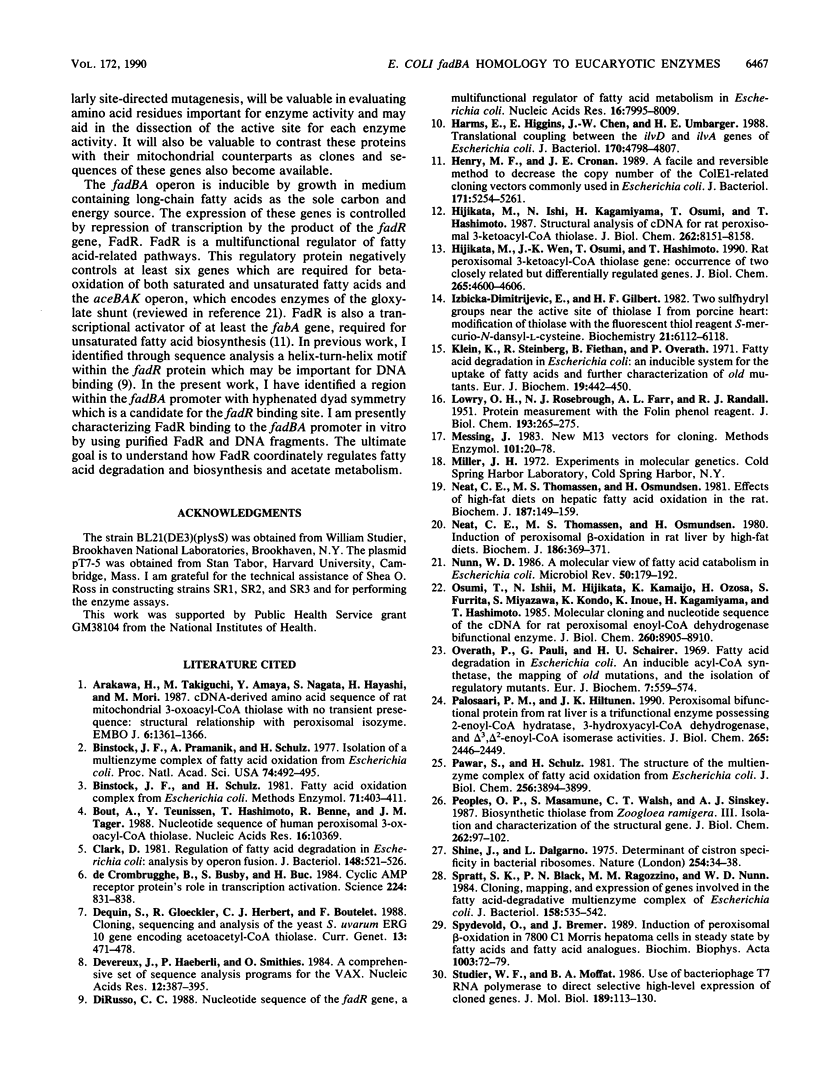
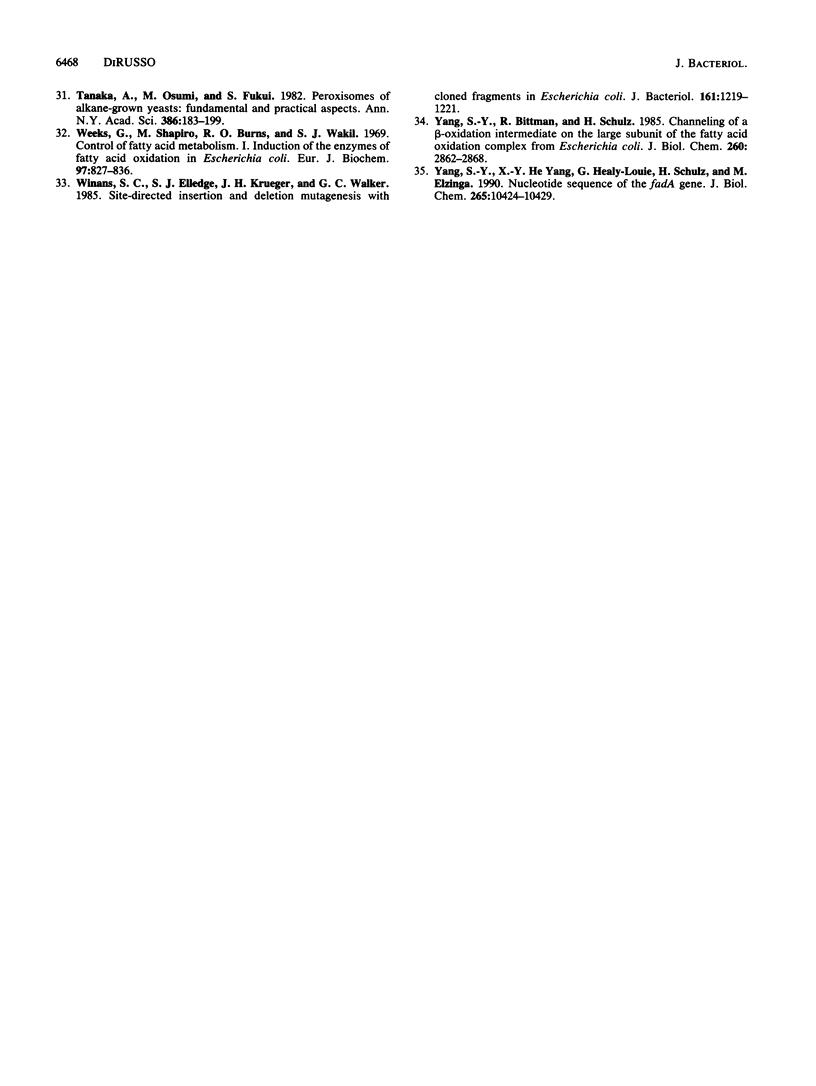
Images in this article
Selected References
These references are in PubMed. This may not be the complete list of references from this article.
- Arakawa H., Takiguchi M., Amaya Y., Nagata S., Hayashi H., Mori M. cDNA-derived amino acid sequence of rat mitochondrial 3-oxoacyl-CoA thiolase with no transient presequence: structural relationship with peroxisomal isozyme. EMBO J. 1987 May;6(5):1361–1366. doi: 10.1002/j.1460-2075.1987.tb02376.x. [DOI] [PMC free article] [PubMed] [Google Scholar]
- Binstock J. F., Pramanik A., Schulz H. Isolation of a multi-enzyme complex of fatty acid oxidation from Escherichia coli. Proc Natl Acad Sci U S A. 1977 Feb;74(2):492–495. doi: 10.1073/pnas.74.2.492. [DOI] [PMC free article] [PubMed] [Google Scholar]
- Binstock J. F., Schulz H. Fatty acid oxidation complex from Escherichia coli. Methods Enzymol. 1981;71(Pt 100):403–411. doi: 10.1016/0076-6879(81)71051-6. [DOI] [PubMed] [Google Scholar]
- Bout A., Teunissen Y., Hashimoto T., Benne R., Tager J. M. Nucleotide sequence of human peroxisomal 3-oxoacyl-CoA thiolase. Nucleic Acids Res. 1988 Nov 11;16(21):10369–10369. doi: 10.1093/nar/16.21.10369. [DOI] [PMC free article] [PubMed] [Google Scholar]
- Clark D. Regulation of fatty acid degradation in Escherichia coli: analysis by operon fusion. J Bacteriol. 1981 Nov;148(2):521–526. doi: 10.1128/jb.148.2.521-526.1981. [DOI] [PMC free article] [PubMed] [Google Scholar]
- Dequin S., Gloeckler R., Herbert C. J., Boutelet F. Cloning, sequencing and analysis of the yeast S. uvarum ERG10 gene encoding acetoacetyl CoA thiolase. Curr Genet. 1988 Jun;13(6):471–478. doi: 10.1007/BF02427752. [DOI] [PubMed] [Google Scholar]
- Devereux J., Haeberli P., Smithies O. A comprehensive set of sequence analysis programs for the VAX. Nucleic Acids Res. 1984 Jan 11;12(1 Pt 1):387–395. doi: 10.1093/nar/12.1part1.387. [DOI] [PMC free article] [PubMed] [Google Scholar]
- DiRusso C. C. Nucleotide sequence of the fadR gene, a multifunctional regulator of fatty acid metabolism in Escherichia coli. Nucleic Acids Res. 1988 Aug 25;16(16):7995–8009. doi: 10.1093/nar/16.16.7995. [DOI] [PMC free article] [PubMed] [Google Scholar]
- Harms E., Higgins E., Chen J. W., Umbarger H. E. Translational coupling between the ilvD and ilvA genes of Escherichia coli. J Bacteriol. 1988 Oct;170(10):4798–4807. doi: 10.1128/jb.170.10.4798-4807.1988. [DOI] [PMC free article] [PubMed] [Google Scholar]
- Henry M. F., Cronan J. E., Jr A facile and reversible method to decrease the copy number of the ColE1-related cloning vectors commonly used in Escherichia coli. J Bacteriol. 1989 Oct;171(10):5254–5261. doi: 10.1128/jb.171.10.5254-5261.1989. [DOI] [PMC free article] [PubMed] [Google Scholar]
- Hijikata M., Ishii N., Kagamiyama H., Osumi T., Hashimoto T. Structural analysis of cDNA for rat peroxisomal 3-ketoacyl-CoA thiolase. J Biol Chem. 1987 Jun 15;262(17):8151–8158. [PubMed] [Google Scholar]
- Hijikata M., Wen J. K., Osumi T., Hashimoto T. Rat peroxisomal 3-ketoacyl-CoA thiolase gene. Occurrence of two closely related but differentially regulated genes. J Biol Chem. 1990 Mar 15;265(8):4600–4606. [PubMed] [Google Scholar]
- Izbicka-Dimitrijević E., Gilbert H. F. Two sulfhydryl groups near the active site of thiolase I from porcine heart: modification of thiolase with the fluorescent thiol reagent S-mercurio-N-dansyl-L-cysteine. Biochemistry. 1982 Nov 23;21(24):6112–6118. doi: 10.1021/bi00267a013. [DOI] [PubMed] [Google Scholar]
- Klein K., Steinberg R., Fiethen B., Overath P. Fatty acid degradation in Escherichia coli. An inducible system for the uptake of fatty acids and further characterization of old mutants. Eur J Biochem. 1971 Apr;19(3):442–450. doi: 10.1111/j.1432-1033.1971.tb01334.x. [DOI] [PubMed] [Google Scholar]
- LOWRY O. H., ROSEBROUGH N. J., FARR A. L., RANDALL R. J. Protein measurement with the Folin phenol reagent. J Biol Chem. 1951 Nov;193(1):265–275. [PubMed] [Google Scholar]
- Messing J. New M13 vectors for cloning. Methods Enzymol. 1983;101:20–78. doi: 10.1016/0076-6879(83)01005-8. [DOI] [PubMed] [Google Scholar]
- Neat C. E., Thomassen M. S., Osmundsen H. Effects of high-fat diets on hepatic fatty acid oxidation in the rat. Isolation of rat liver peroxisomes by vertical-rotor centrifugation by using a self-generated, iso-osmotic, Percoll gradient. Biochem J. 1981 Apr 15;196(1):149–159. doi: 10.1042/bj1960149. [DOI] [PMC free article] [PubMed] [Google Scholar]
- Neat C. E., Thomassen M. S., Osmundsen H. Induction of peroxisomal beta-oxidation in rat liver by high-fat diets. Biochem J. 1980 Jan 15;186(1):369–371. doi: 10.1042/bj1860369. [DOI] [PMC free article] [PubMed] [Google Scholar]
- Nunn W. D. A molecular view of fatty acid catabolism in Escherichia coli. Microbiol Rev. 1986 Jun;50(2):179–192. doi: 10.1128/mr.50.2.179-192.1986. [DOI] [PMC free article] [PubMed] [Google Scholar]
- Osumi T., Ishii N., Hijikata M., Kamijo K., Ozasa H., Furuta S., Miyazawa S., Kondo K., Inoue K., Kagamiyama H. Molecular cloning and nucleotide sequence of the cDNA for rat peroxisomal enoyl-CoA: hydratase-3-hydroxyacyl-CoA dehydrogenase bifunctional enzyme. J Biol Chem. 1985 Jul 25;260(15):8905–8910. [PubMed] [Google Scholar]
- Overath P., Pauli G., Schairer H. U. Fatty acid degradation in Escherichia coli. An inducible acyl-CoA synthetase, the mapping of old-mutations, and the isolation of regulatory mutants. Eur J Biochem. 1969 Feb;7(4):559–574. [PubMed] [Google Scholar]
- Palosaari P. M., Hiltunen J. K. Peroxisomal bifunctional protein from rat liver is a trifunctional enzyme possessing 2-enoyl-CoA hydratase, 3-hydroxyacyl-CoA dehydrogenase, and delta 3, delta 2-enoyl-CoA isomerase activities. J Biol Chem. 1990 Feb 15;265(5):2446–2449. [PubMed] [Google Scholar]
- Pawar S., Schulz H. The structure of the multienzyme complex of fatty acid oxidation from Escherichia coli. J Biol Chem. 1981 Apr 25;256(8):3894–3899. [PubMed] [Google Scholar]
- Peoples O. P., Masamune S., Walsh C. T., Sinskey A. J. Biosynthetic thiolase from Zoogloea ramigera. III. Isolation and characterization of the structural gene. J Biol Chem. 1987 Jan 5;262(1):97–102. [PubMed] [Google Scholar]
- Shine J., Dalgarno L. Determinant of cistron specificity in bacterial ribosomes. Nature. 1975 Mar 6;254(5495):34–38. doi: 10.1038/254034a0. [DOI] [PubMed] [Google Scholar]
- Spratt S. K., Black P. N., Ragozzino M. M., Nunn W. D. Cloning, mapping, and expression of genes involved in the fatty acid-degradative multienzyme complex of Escherichia coli. J Bacteriol. 1984 May;158(2):535–542. doi: 10.1128/jb.158.2.535-542.1984. [DOI] [PMC free article] [PubMed] [Google Scholar]
- Spydevold O., Bremer J. Induction of peroxisomal beta-oxidation in 7800 C1 Morris hepatoma cells in steady state by fatty acids and fatty acid analogues. Biochim Biophys Acta. 1989 May 15;1003(1):72–79. doi: 10.1016/0005-2760(89)90101-x. [DOI] [PubMed] [Google Scholar]
- Studier F. W., Moffatt B. A. Use of bacteriophage T7 RNA polymerase to direct selective high-level expression of cloned genes. J Mol Biol. 1986 May 5;189(1):113–130. doi: 10.1016/0022-2836(86)90385-2. [DOI] [PubMed] [Google Scholar]
- Tanaka A., Osumi M., Fukui S. Peroxisomes of alkane-grown yeast: fundamental and practical aspects. Ann N Y Acad Sci. 1982;386:183–199. doi: 10.1111/j.1749-6632.1982.tb21416.x. [DOI] [PubMed] [Google Scholar]
- Weeks G., Shapiro M., Burns R. O., Wakil S. J. Control of fatty acid metabolism. I. Induction of the enzymes of fatty acid oxidation in Escherichia coli. J Bacteriol. 1969 Feb;97(2):827–836. doi: 10.1128/jb.97.2.827-836.1969. [DOI] [PMC free article] [PubMed] [Google Scholar]
- Winans S. C., Elledge S. J., Krueger J. H., Walker G. C. Site-directed insertion and deletion mutagenesis with cloned fragments in Escherichia coli. J Bacteriol. 1985 Mar;161(3):1219–1221. doi: 10.1128/jb.161.3.1219-1221.1985. [DOI] [PMC free article] [PubMed] [Google Scholar]
- Yang S. Y., Bittman R., Schulz H. Channeling of a beta-oxidation intermediate on the large subunit of the fatty acid oxidation complex from Escherichia coli. J Biol Chem. 1985 Mar 10;260(5):2862–2868. [PubMed] [Google Scholar]
- Yang S. Y., Yang X. Y., Healy-Louie G., Schulz H., Elzinga M. Nucleotide sequence of the fadA gene. Primary structure of 3-ketoacyl-coenzyme A thiolase from Escherichia coli and the structural organization of the fadAB operon. J Biol Chem. 1990 Jun 25;265(18):10424–10429. [PubMed] [Google Scholar]
- de Crombrugghe B., Busby S., Buc H. Cyclic AMP receptor protein: role in transcription activation. Science. 1984 May 25;224(4651):831–838. doi: 10.1126/science.6372090. [DOI] [PubMed] [Google Scholar]



